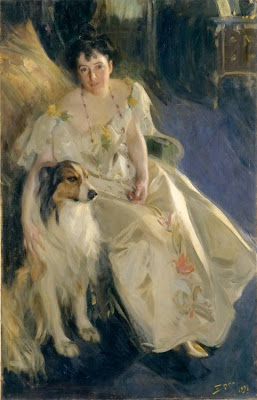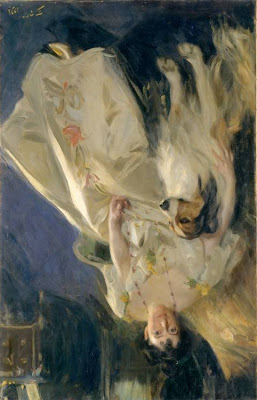Anders Zorn (Sweedish, 1860 – 1920), Portrait of Mrs. Walter Rathbone Bacon
Apparently that is actually the title of the painting and the poor woman’s name isn’t going to be revealed to us. That said, what a nice dog (also nameless, apparently) and moreover, what a stunning composition. We know we are never going to actually meet this woman or her proud looking hound. That Zorn could make us want to look more than once at this woman and her dog is proof of his remarkable skill as a painter.
So often paintings, especially realist paintings, reveal some of their abstract artistry turned upside down. Zorn had an eye for making connections and instilling movement into his paintings. Look at the same painting inverted and see how he broke his canvas up into two basic flat shapes. Sharply angular, they push and pull our eyes rapidly around the canvas.
The woman and her dog merge together to create a huge light colored triangle pushing all the way from one side of the canvas to the other. Everything outside this light area is pushed darker. I especially love the color harmony Zorn sets up between his glowing delicate yellows in the silk dress and the restrained blue grays of the floor.
Zorn seems to have played around a great deal, adjusting his props to get the most powerful expression from his arrangement. One of my favorites is the yellowish cloth behind the woman’s shoulder that seems draped over the back of her chair. He’s lined up its long diagonal side to reinforce the long diagonal edge of his giant light triangle shape. It works beautifully.
I think what Zorn is saying with a painting like this is that things aren’t either as fragmented or as isolated as they often appear. As a painter, all Zorn can do is show us relationships and connections in a way that is a little more obvious than they are to the casual observer. So he’s pushed and pulled at the outlines of his woman, her dress, and her dog to make them come together as a team that generates that big light triangle form. (I fantasize them proudly saying to us “See, we’re part of something bigger”).
Zorn looks like he worked very quickly with is broad and quick moving brush strokes. But I bet in truth he took his time with this painting, looking and considering, toying with alternatives, and painting and repainting passages that he sensed could be made better.
The magnificent dog for example. What are the chances the dog’s fur really came so close to matching the colors of the woman’s dress. Fido’s chest fur is a touch cooler in color, but that gradates back to exactly the dress color as Zorn reaches the the dog’s hind quarters. I think the artist is lying to us just a little bit, making the dog look like it’s just has his fur color retouched at the Canine Hair Salon to fit his owners choice of gown.
One little detail I think is utterly charming is the way Zorn paints the sitter’s hand gently sinking into the long fur on her dog’s shoulder. This could have been rendered with much darker shadows in between all of her splayed out fingers. Zorn would have none of that. He felt he had said enough with the dramatic dark and light contrasts in the dog’s head and the side of his furry mane, so the woman’s hand had to be subordinated.
That sort of orchestration of the little parts to the whole overall composition is so elegantly convincing in this painting. Sure this woman and her faithful hound no doubt have left us long ago. But there they are staring out at us from the depths of Zorn’s brushstrokes looking as alive, or perhaps more alive, than most of the people (and dogs) we’ve seen in the past month. I think there is magic to good painting. When a painter paints this well the artist is gently shaking us with his brushstrokes, waking us up a little more and brushing off of us some of our dullness and sleepy lethargy. “Here” he says with an earnest smile, “I’ve something bright and fresh to show you.”
Note: I’m happy to announce the Burchfield Penny Art Center, one of the two major art museums in Buffalo, NY published my previous piece on one of Charles Burchfield’s watercolors on their museum blog. You can read it here.
Read more about Contributor Philip Koch at http://philipkochpaintings.blogspot.com.






